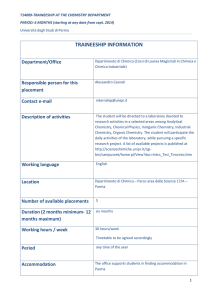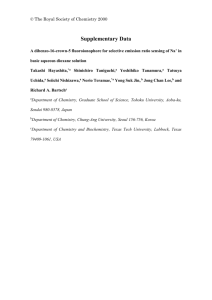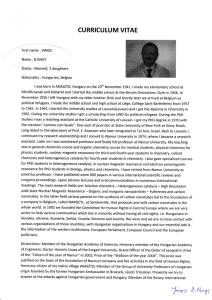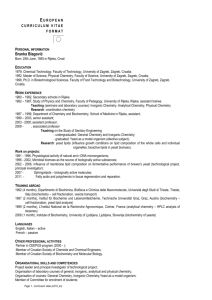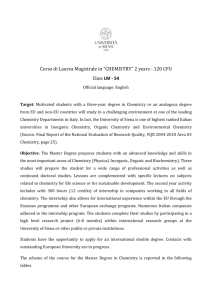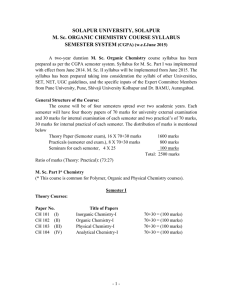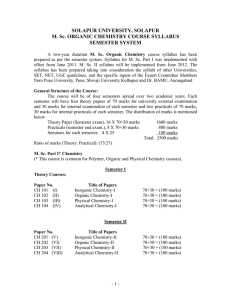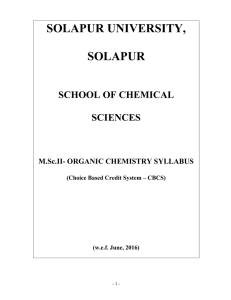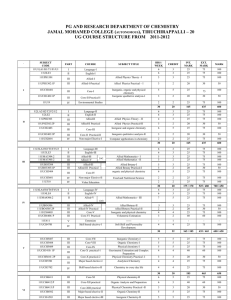INORGANIC CHEMISTRY TRANSITION ELEMENTS
advertisement
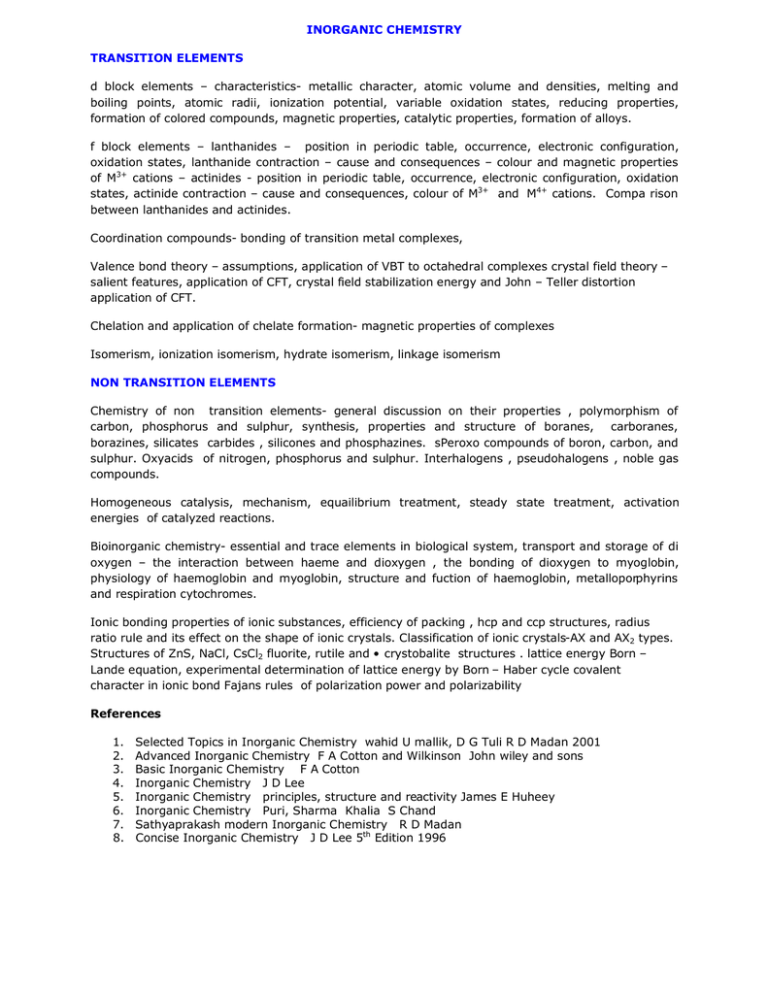
INORGANIC CHEMISTRY TRANSITION ELEMENTS d block elements – characteristics- metallic character, atomic volume and densities, melting and boiling points, atomic radii, ionization potential, variable oxidation states, reducing properties, formation of colored compounds, magnetic properties, catalytic properties, formation of alloys. f block elements – lanthanides – position in periodic table, occurrence, electronic configuration, oxidation states, lanthanide contraction – cause and consequences – colour and magnetic properties of M3+ cations – actinides - position in periodic table, occurrence, electronic configuration, oxidation states, actinide contraction – cause and consequences, colour of M3+ and M4+ cations. Compa rison between lanthanides and actinides. Coordination compounds- bonding of transition metal complexes, Valence bond theory – assumptions, application of VBT to octahedral complexes crystal field theory – salient features, application of CFT, crystal field stabilization energy and John – Teller distortion application of CFT. Chelation and application of chelate formation- magnetic properties of complexes Isomerism, ionization isomerism, hydrate isomerism, linkage isomerism NON TRANSITION ELEMENTS Chemistry of non transition elements- general discussion on their properties , polymorphism of carbon, phosphorus and sulphur, synthesis, properties and structure of boranes, carboranes, borazines, silicates carbides , silicones and phosphazines. sPeroxo compounds of boron, carbon, and sulphur. Oxyacids of nitrogen, phosphorus and sulphur. Interhalogens , pseudohalogens , noble gas compounds. Homogeneous catalysis, mechanism, equailibrium treatment, steady state treatment, activation energies of catalyzed reactions. Bioinorganic chemistry- essential and trace elements in biological system, transport and storage of di oxygen – the interaction between haeme and dioxygen , the bonding of dioxygen to myoglobin, physiology of haemoglobin and myoglobin, structure and fuction of haemoglobin, metalloporphyrins and respiration cytochromes. Ionic bonding properties of ionic substances, efficiency of packing , hcp and ccp structures, radius ratio rule and its effect on the shape of ionic crystals. Classification of ionic crystals-AX and AX2 types. Structures of ZnS, NaCl, CsCl2 fluorite, rutile and • crystobalite structures . lattice energy Born – Lande equation, experimental determination of lattice energy by Born – Haber cycle covalent character in ionic bond Fajans rules of polarization power and polarizability References 1. 2. 3. 4. 5. 6. 7. 8. Selected Topics in Inorganic Chemistry wahid U mallik, D G Tuli R D Madan 2001 Advanced Inorganic Chemistry F A Cotton and Wilkinson John wiley and sons Basic Inorganic Chemistry F A Cotton Inorganic Chemistry J D Lee Inorganic Chemistry principles, structure and reactivity James E Huheey Inorganic Chemistry Puri, Sharma Khalia S Chand Sathyaprakash modern Inorganic Chemistry R D Madan Concise Inorganic Chemistry J D Lee 5th Edition 1996 PHYSICAL CHEMISTRY Thermodynamics- 1st law, limitations , 2nd law spontaneous processes, cyclic processes, Carnot’s cycle and 3rdlaw – relation between CP and CV, enthalpies of physical and chemical changes. Temperature dependence of enthalpies, entropy, Gibb’s – Helmholtz equation, calculation of entropies, entropy change in isothermal expansion of an ideal gas, in reversible and irreversible processes. Wok and free energy functions, Maxwell’s relationships. Claperon equation, Claperon – Clausius equation Chemical Kinetics – methods of determining rate laws. Rate equation, order of a reaction, illustration ofm 1st, 2nd 3rd and zero order reactions, half life time, order and molecularity of a simple reaction, mechanism of a complex reaction, collision theory, effect of temperature and temperature on reaction rate, concept of energy of activation and its experimental determination, energy barrier, effect of catalyst, Arrhenius equation Surface chemistry types of adsorption, physisorption, chemisorption , heats of adsorption, mechanism of chemisorptions, rate of chemisorptions, hysteresis, Freundlich adsorption isotherm, adsorption isotherms, Langmuir and BET adsorption BET equation for surface area.gibbb’s adsorption insoluble surface films on liquids. Catalysis – definition, types of homogeneous and heterogeneous catalysis, effect of temperature and diffusion limitation Michaelis – Menten kinetics. Negative catalysis, characteristics of catalysis. Electrochemistry: Arrhenius theory of strong and weak electrolytes and its limitations, Debye – Huckel theory of strong electrolytes, Debye – Huckel – Onsager conductance equation, Debye – Huckel limiting equation for activity coefficient- Liquid junction potential and its determination. References 1. 2. 3. 4. 5. 6. 7. 8. 9. Physical chemistry Atkins ELBS, and oxford University Press, 2005 Physical chemistry Puri , Sharma and Patania S. Chand Advanced Physical chemistry Gurdeep Raj Physical chemistry Barrow 5th edition Tata McGraw Hill 1992 A text Book of Physical chemistry Samuel Gasstone 2nd Edition McMillan India ltd. 1998 Electrochemistry M S Yadav Anmol Publications Pvt. Ltd. Basic Physical chemistry W. J. Moore Chemical Kinetics Leidler Harper and Row Delhi Adsorption and catalysis chakravarthi ORGANIC REACTION MECHANISMS Fundamentals of reaction mechanism : homolytic and heterolytic cleavage, carbocations, carbanions, free radical- , generation and characteristic reactions, inductive and electromeric effects, resonance effect. Addition reactions : addition reactions to aldehydes and ketones – hydrogen cyanide, alcohol, Grignard reagent. Aliphatic nucleophilic substitutionsmechanism and scope, SN1, SN2 and SNi reactions, stereochemistry, allylic reactions , neighbouring group participation, factors influencing the substitution reactions – leaving group, substrate, nucleophile, solvents, on the rate of the nucleophilic substitution reactions, comparison between SN1and SN2 reactions, Elimination reactions: E1 and E2 reactions, mechanism, Saytzev rule, stereochemistry, Aromatic electrophilic substitutions- mechanism of nitration, sulphonation, Friedel crafts alkylation and acylation, Aromaticiity – Huckel’s rule and its application to various systems. Mechsnim of Reformatsky, Knoevenagel, Perkin’s reactions, aldol condensation. References: 1. 2. 3. 4. 5. 6. 7. 8. 9. 10. 11. 12. Organic reactions and their mechanisms P.S. Kalsi New Age New Delhi 1996 Advanced Organic Chemistry 4th Edition, J. March Wiley inter 2000 Organic reaction mechanisms Bansal Tata McGraw Hill, New Delhi 1978 Organic Chemistry volo. I and II Mukerjee, Singh and Kapoor wiley eastern New Delhi 1985 Modern synthetic reactions H. O House Benjamin 1972 Organic Chemistry I L Finar Vol I and II Organic Chemistry Morrisson and Boyd prentice Hall 1998 A guide Book to mechanism in organic chemistry by Peter Sykes Longman 2000 Reaction mechanisms and reagents in organic chemistry Chatwal , Himalaya Bombay 1989 Mechanism and theory in organic chemistry Lowry and Richardson Harper and Row 1987 Chemistry of carbonyl compounds David Gutsche Prentice Hall New Delhi 1988 Organic Chemistry P Y Bruice Pearson Education, New Delhi 2002 ANALYTICAL CHEMISTRY Chromatography- classification, Theory – distribution coefficient, rate of travel, retention time, adjusted retention time, retention volume , net retention volume, specific retention volume, relative retention, Van Deemer equation, resolution,- Gas chromatography – carrier gas, stationary phase, instrumentation, qualitative and quantitative analysis, effect of temperature on retention. HPLC – Principle, Instrumentation, Detectors, Mobile phase selection, HPLC – MS chromatography. V spectra -Chromophores and auxochromes, intensity of absorption bands – factors atnat affect the intensity, spectra of dienes, unsaturated carbonyl compounds. Ir spectra - vibrational frequency, and factors that affect tem, finger print region and its significance, identification of functional groups and inter and intra molecular hydrogen bondsing. Importance of far infrared region. 1 H NMR spectra – coupling constants, - germinal, vicinal and long range coupling constants, chemical shifts – factors that influence the shift, proton coupling, Kaarplus equation, spin decoupling. Identification of structure of compounds based on the NMR. 13 C NMR Chemical shifts, use of INEPT and DEFT methods in assigning the signals. 13C NMR of some organic compounds. References 1.Dyer J R Applications of absorption spectroscopy of organic compounds, Prentice Hall. 1978 2. Silverstein and Webster Spectrometric identification of organic compounds , Sixth edition, Wiley, 1998 3. Kemp. W Organic spectroscopy , 3rd edition, ELBS, NEW Delhi 1989 4. P.S. Kalsi Organic Chemistry Tata McGraw Hill, New Delhi. 5. Introduction to molecular spectroscopy C N Banwell, TMH edition, 1994 6. Electronic absorption spectroscopy and related techniques D.N. sathyanarayana University Press 2001 7.Vibrational Spectroscopy , D.N. sathyanarayana New Age International Pvt. Ltd.1996 8. Principles of Instrumental analysis Skoog and West and Hollar Asia Pvt. Ltd. 9. Vogel’s text book of quantitative chemical analysis revised 10. Instrumental Methods of analysis Galen W Ewing 11. Basic concepts of analytical chemistry S M Kopkar
